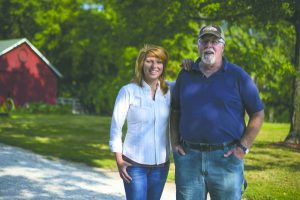R.F.D. NEWS & VIEWS: Special initiatives, sowing oats and more
By Tim Alexander for Chronicle Media — March 14, 2019
Kate Danner and her father, John Longley, are pictured on their Aledo farm. Danner is a board member of Illinois Corn, while Longley is a district director for the Illinois Soybean Association. (ICGA photo)
In this week’s column, we have dates for the implementation of key facets of the 2018 Farm Bill, including deadlines for Illinois conservation programs. Also this week: the University of Illinois Extension is urging small farmers to plant more oats for agronomic and economic benefits, and we have a profile of Kate Danner, the newest member of Illinois Corn’s board of directors. Please read on …
Nielsen: Commodity program signup starts Sept. 1
BLOOMINGTON — The Illinois Farm Bureau was relieved to hear U.S. Agriculture Secretary Sonny Perdue tell the House Agriculture Committee that commodity program signup under the 2018 Farm Bill would not begin until Sept. 1. It was welcome news to Adam Nielsen, IFB director of national legislation and policy development, who said that while Illinois farmers are excited about the improvements made to the Agricultural Risk Coverage and Price Loss Coverage commodity programs in the new farm bill, they haven’t had much time to study them.
“Giving farmers time to get in the field, time to absorb market and yield data, and time to become familiar with commodity program changes will put farmers in the best position to make the right decision,” Nielsen wrote in a letter sent to the Federal Register.
The IFB also praised the farm bill’s enhanced Farm Service Agency loan limits and recommended early implementation, and urged the FSA to allow farmers to insure their spring planted crops into a standing cover crop without any reduction in coverage. In addition, IFB urged funding for adequate USDA-Natural Resources Conservation Service staffing, and allowing Conservation Stewardship Program enhancements to be eligible for Environmental Quality Incentives Program funding. (IFB news)
EQIP, Illinois initiative funding announced
CHAMPAIGN — Application deadlines for Illinois NRCS’ primary financial assistance program, EQIP, were announced for April 19 and May 17 by Illinois State Conservationist Ivan Dozier. Hundreds of Illinois agricultural and forestland producers have utilized the program in the past to address natural resource issues, installing structures to address gully erosion, improving pasture land diversity, and improving soil health.
In Illinois, a special funding pool was created in the 2018 Farm Bill to encourage improvements in monarch butterfly habitat with stands of milkweed and nectar plants. These conservation practices can be completed through NRCS EQIP funding pools, in areas such as grazing land operations, confined livestock operations, organic, monarch butterfly and wildlife habitat, among other areas. EQIP funds can also be utilized for plan development such as Comprehensive Nutrient Management Plans, Drainage Water Plans, and others.
“NRCS has a long history of conservation planning with agricultural producers and forestry managers,” said Dozier, in an Illinois NRCS news release. “We have the technical knowledge to develop a conservation plan for your resource concerns and NRCS has conservation programs to help you implement that plan.”
Special Illinois initiatives announced by NRCS
CHAMPAIGN — In addition to announcing EQIP signup dates, Illinois NRCS also announced application cutoff dates for special Illinois Landscape Conservation Initiatives. Farmers in the following areas have until April 19 or May 17 to submit applications for projects qualifying under the Mississippi River Basin Health Watersheds Initiative: Clinton Lake, Crow Creek West-Clear Creek, Upper Macoupin Creek and Vermilion Headwaters. In addition, National Water Quality Initiative Funding is available for projects in the Douglas Creek Watershed, Crooked Creek-Bon Pos Watershed, Lake Vermilion Watershed, Lake De Revey Watershed, Painter Creek Watershed, Lake Bloomington-Money Creek Watershed and Blue Mound-Money Creek Watershed. Landowners should contact their local USDA-NRCS field office to obtain more details about specific initiatives and how to apply. (Illinois USDA-NRCS)
Illinois Farm Fact:
Only 35,000 acres of oats were grown in Illinois in 2017. (U of I Extension)
Extension: Time to sow more oats
BLOOMINGTON — Social barriers prohibit many Illinois farmers from growing what was once nearly a staple crop in Illinois: oats. This is the conclusion of Bill Davison, University of Illinois Extension educator for Livingston, McLean and Woodford counties, who lamented that hardly any Illinois farmers grow oats anymore. “A farmer who chooses to grow oats is operating outside the norms of his or her social group, which is difficult and stressful and can have serious ramifications beyond the farm,” Davison stated in a March 6 essay, Oats Offer a Gateway to Profitability. “For those able to change, opportunities are revealed.”
Current market conditions, with uncertainty surrounding prices associated with Illinois’ current two-crop monoculture, make now the time to consider branching out into oats or other small grains, according to Davison. “A good way for farmers to begin to realize the benefits of diverse rotations is to connect with other farmers that are doing it, perhaps beyond your normal social circles. From there, start small, learn as you go, and scale up production as your skills and markets develop.”
Danner joins ICGA board of directors
BLOOMINGTON — Like father, like daughter: Aledo farmer Kate Danner is following her father’s lead in assuming a leadership role with a top Illinois farm commodity association. Danner, an at-large director for the Illinois Corn Growers Association, also sits on the ICGA Exports Committee and on the National Corn Growers Association Freedom to Operate Action Team.
“I know I don’t look like a ‘normal’ farmer, but when I sit with a group of farmers and we talk about hybrids, yields, fertilizer recommendations, and policy, my farmer-peers realize I am knowledgeable in my experiences,” Danner said. “I feel accepted and welcomed.”
Danner is the daughter of Illinois Soybean Association District 3 director John Longley. The pair have farmed together for the past seven years. (ICGA news)
–R.F.D. NEWS & VIEWS: Special initiatives, sowing oats and more–



